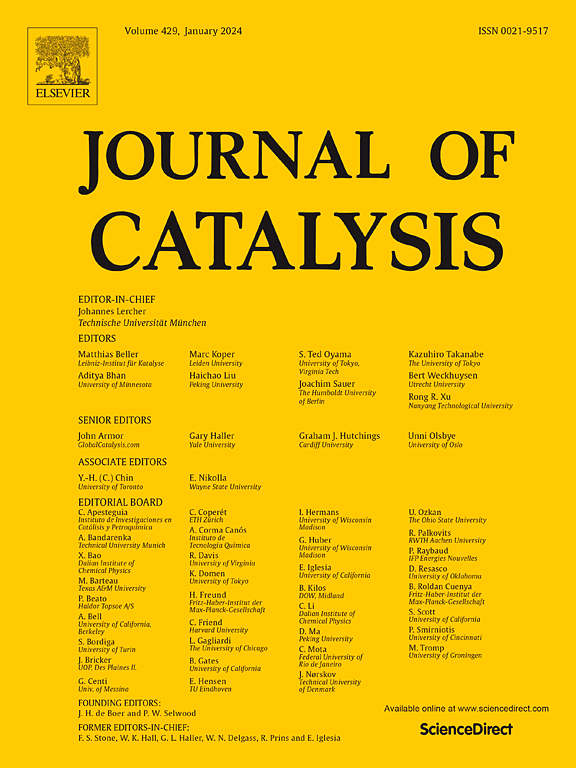亚胺到酰胺的键转化促进二维共价有机框架光催化整体水分裂:极性效应的作用
IF 6.5
1区 化学
Q2 CHEMISTRY, PHYSICAL
引用次数: 0
摘要
亚胺基共价有机骨架(Im-COFs)由于其易于合成和结构稳定,在光催化整体水分解(OWS)中引起了广泛的关注。然而,大多数Im-COFs光催化剂面临着光生载流子快速重组的挑战,导致太阳能到氢(STH)的转换效率较低。在这里,我们提出在二维(2D) Im-COFs中将亚胺键氧化为酰胺键将是一种有效的策略,以增强平面内极性,从而促进光生载流子的分离。基于第一性原理计算,以两种酰胺连接的2,4,6-三苯基-1,3,5-三嗪(TST)和三苯胺(TA)单层膜(Am-TST, Am-TA)为模型,比较了它们与亚胺连接单层膜(Im-TST, Im-TA)的光催化性能。有趣的是,两种酰胺连接的COFs都表现出ii型带排列,而亚胺连接的COFs则没有。此外,非绝热分子动力学(NAMD)模拟表明,光生载流子Am-TST单层的寿命(13.41 ns)比Im-TST单层长3.45倍,表明酰胺键抑制光激发载流子重组的能力更强。此外,Am-TST单层也可以实现可见光驱动的光催化OWS活性,并且利用Am-TST双层可以进一步提高光吸收能力。这些发现揭示了亚胺-酰胺键转化在促进光生载体分离中的作用,为设计面向OWS的酰胺基COFs光催化剂提供了一种有希望的策略。本文章由计算机程序翻译,如有差异,请以英文原文为准。


Linkages conversion of imine to amide promotes photocatalytic overall water splitting in Two-Dimensional covalent organic frameworks: The role of polarity effects
Imine-based covalent organic frameworks (Im-COFs) have attracted extensive attention in photocatalytic Overall Water Splitting (OWS) due to their facile synthesis and structural stability. However, most of the Im-COFs photocatalysts face the challenge of rapid recombination of photogenerated carriers, leading to low Solar-To-Hydrogen (STH) conversion efficiency. Here, we propose that the oxidation of imine to amide linkages in two-dimensional (2D) Im-COFs would be an effective strategy to enhance the in-plane polarity and thus facilitate the separation of photogenerated carriers. Based on first principles calculations, Two amide-linked 2,4,6-triphenyl-1,3,5-triazine (TST) and Triphenylamine (TA) monolayers (Am-TST, Am-TA) were used as model to compare the photocatalytic performance with the imine-linked ones (Im-TST, Im-TA). Interestingly, both the amide-linked COFs exhibit type-II band alignments, which is absent in the imine-linked ones. Moreover, the Non-Adiabatic Molecular Dynamics (NAMD) simulations reveal the photogenerated carriers’ lifetime Am-TST monolayer (13.41 ns) is 3.45 times longer than that of Im-TST monolayer, indicating the superior ability of amide linkages in suppressing the recombination of photoexcited carriers. In addition, the Am-TST monolayer can also achieve visible-light-driven photocatalytic OWS activity, and the light absorption capability can be further improved by using the Am-TST bilayer. These findings reveal the role of imine-to-amide linkages conversion in promoting the separation of photogenerated carriers, providing a promising strategy for designing amide-based COFs photocatalysts towards OWS.
求助全文
通过发布文献求助,成功后即可免费获取论文全文。
去求助
来源期刊

Journal of Catalysis
工程技术-工程:化工
CiteScore
12.30
自引率
5.50%
发文量
447
审稿时长
31 days
期刊介绍:
The Journal of Catalysis publishes scholarly articles on both heterogeneous and homogeneous catalysis, covering a wide range of chemical transformations. These include various types of catalysis, such as those mediated by photons, plasmons, and electrons. The focus of the studies is to understand the relationship between catalytic function and the underlying chemical properties of surfaces and metal complexes.
The articles in the journal offer innovative concepts and explore the synthesis and kinetics of inorganic solids and homogeneous complexes. Furthermore, they discuss spectroscopic techniques for characterizing catalysts, investigate the interaction of probes and reacting species with catalysts, and employ theoretical methods.
The research presented in the journal should have direct relevance to the field of catalytic processes, addressing either fundamental aspects or applications of catalysis.
 求助内容:
求助内容: 应助结果提醒方式:
应助结果提醒方式:


